Wild Animals Use Psychedelics In Nature
Psychedelics are a subclass of hallucinogenic drugs whose primary effect is to trigger non-ordinary mental states and an apparent expansion of consciousness
It is completely normal for wild animals to use psychedelics, reindeer consume Amanita muscaria which contains muscimol, a compound that induces a sedative and hallucinogenic effect. The caribou’s urine with psychoactive agents is so potent that they will battle each other to earn access to the urine of a herd mate that has fly agaric in its system. A habit shared with human Siberian tribes who also drink the urine to get high. Jaguars in turn consume the leaves of the yagé vine (Banisteriopsis caapi*)* after which they lay down and start to trip, some South American tribes believe the effects of the vine improve hunting skills in animals.
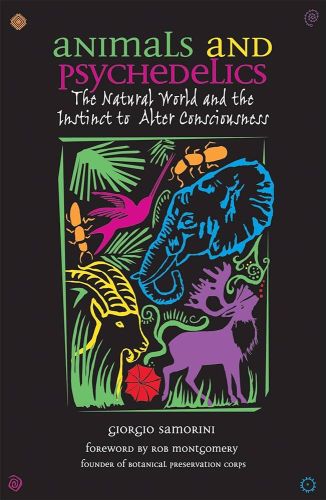
Iboga (Tabernanthe iboga) is a shrub native to the tropical rainforests of Central Africa which contains ibogaine in its bark, a hallucinogenic chemical. Several species, including wild boars, porcupines, gorillas, and other primates, consume this. Various wild animal species consume magic mushrooms, including dogs and goats. Goats also use mescal beans, another hallucinogenic. Baboons eat the red fruit of a tree related to Cycadaceae which causes euphoria in humans. Koalas feed on the leaves of eucalyptus which has narcotic and relaxing effects on them. Maybe one of the few instances where the term food addiction is biologically plausible.
Rats and swine raid kava plantations. Cows and horses, deer and monkeys raid marihuana plantations. Lambs break into hemp fields. White-tailed rabbits have been observed invading specialized gardens growing Astrophytum myriostigma, a psychoactive cactus. Sheep roam for hallucinogenic lichen. In Australia, wallabies have been observed stuffing themselves with poppy plants. Insects get drunk and use psychoactive alkaloids. Animals like cats use catnip to get high, several animal species use caffeine. The list is endless.
Evolutionary Exposure To Psychedelics
While direct evidence for the use of psychedelics by our ancient ancestors is sparse, the use of natural psychoactive substances is well-documented among indigenous human cultures worldwide. These practices often serve spiritual, medicinal, and social purposes, suggesting a long history of human interest in altering consciousness.
Human ancestors as primates would have been exposed to psychedelics in natural settings, this exposure would have been further increased very early in their evolution when exploring the forest floors, going bipedal. Things like psychedelic fungi would have been already present for millions of years before hominids and were widely available across the globe.
In the savannah and other ecosystems, the dung of herbivorous animals provides a nutrient-rich substrate that supports the growth of a variety of fungi, including psilocybin-containing mushrooms. Our ancestors would have had a steady supply to use as a form of self-medication in regards to the potent anti-inflammatory action, as a parasite medication, or for religion or recreational drug use.
It is against the backdrop of this ecosystem that 2 million years ago the size of the hominid brain tripled. This has led to the postulation of Terence McKenna (1946-2000), that the consumption of psychedelic fungi may have played a crucial role in the development of the human mind and culture, a theory which was later, by others, dubbed, somewhat jokingly; “the stoned ape theory”. This theory can hardly be called scientifically validated but it was more subtle than the ridiculed name implies.
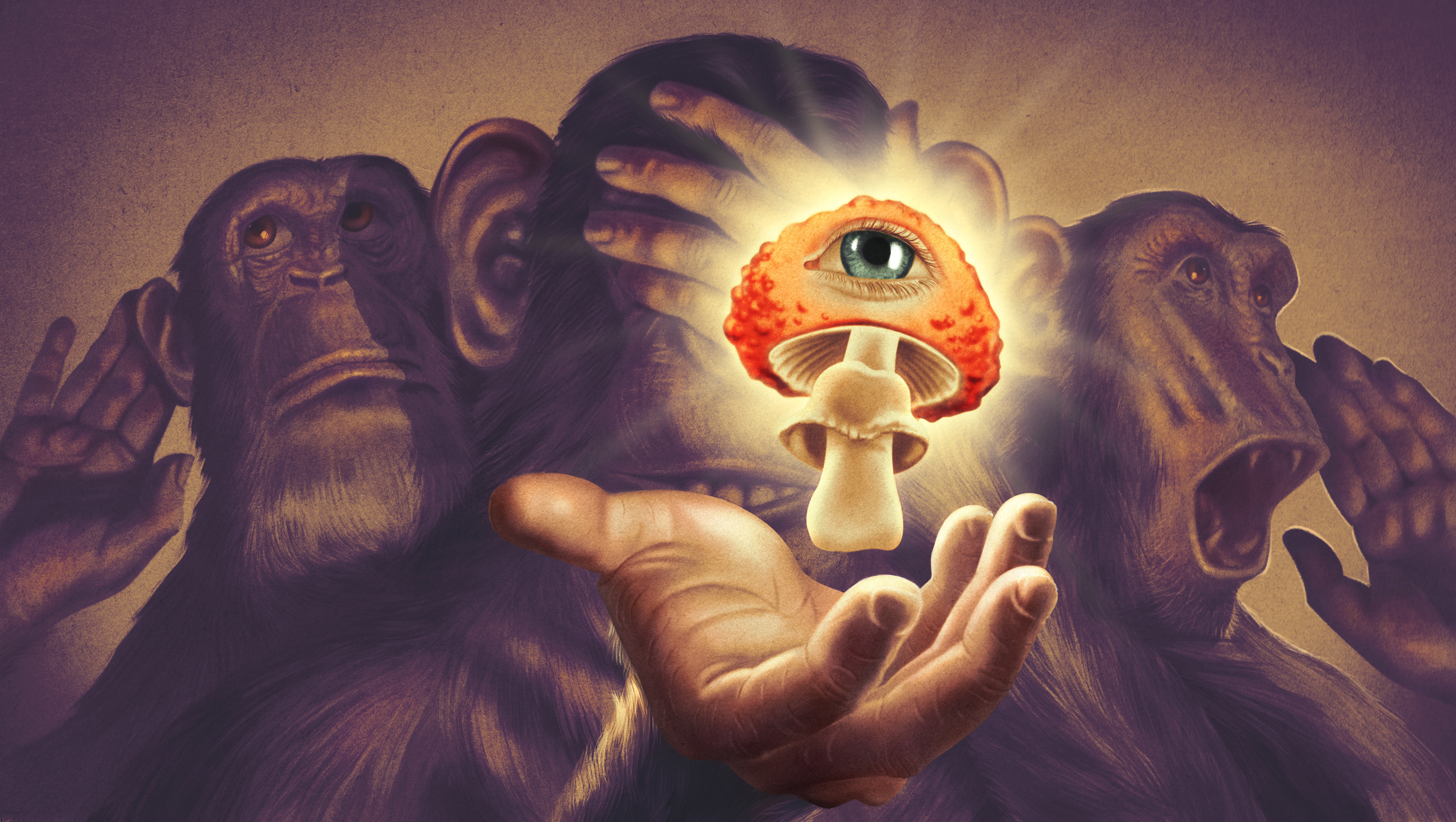
While psychedelics like psilocybin can induce profound experiences and temporarily alter perception, cognition, and emotions, there is limited evidence to suggest that occasional consumption could have permanent effects on brain structure or function that would be passed down through generations in a way that drives evolutionary change. But I’m not sure that this is what the theory was claiming to begin with. Mycologist Paul Stamets argues that these mushrooms may have allowed our ancestors to forge connections between sounds, symbols, and meanings, which is the essence of 'the creative explosion': human language, symbol manipulation, and communication.
I think the truth sits somewhere in between, there is IMO very little doubt about hominids using psychedelics as self-medication. This should be self-evident looking at organisms self-medicating in any way possible in the natural world.
On a background of increased nutrient availability (the real brain builders like DHA omega-3’s, protein, fats, and micronutrients), psychedelics could have contributed as a growth factor by enhancing this size revolution through serotonin signaling, adding plasticity and neurogenesis, which are now, known, evidence-based properties of psychedelics. But our brain size was dependent on so many other factors, such as smaller cheekbones that enabled the housing of bigger brains.
How do psychedelics affect our brains and bodies?
Serotonin, a neurotransmitter, is found across a broad spectrum of life forms, from ancient organisms without nervous systems to humans, indicating its existence predates the development of nervous systems both in terms of individual growth and evolutionary history.
During human evolution, our brains started to distribute serotonin receptors (5-HT2A) in a much greater amount. Especially in the cortex, this greater distribution of 5-HT2A spurred the development of the transmodel cortex (memory, theory of mind, language, decision-making, and sensory integration), the part of the brain that makes humans, human. 5-HT2A did this by signaling neural progenitor cells and stimulating their proliferation during early brain development which buffed up our huge cortex.
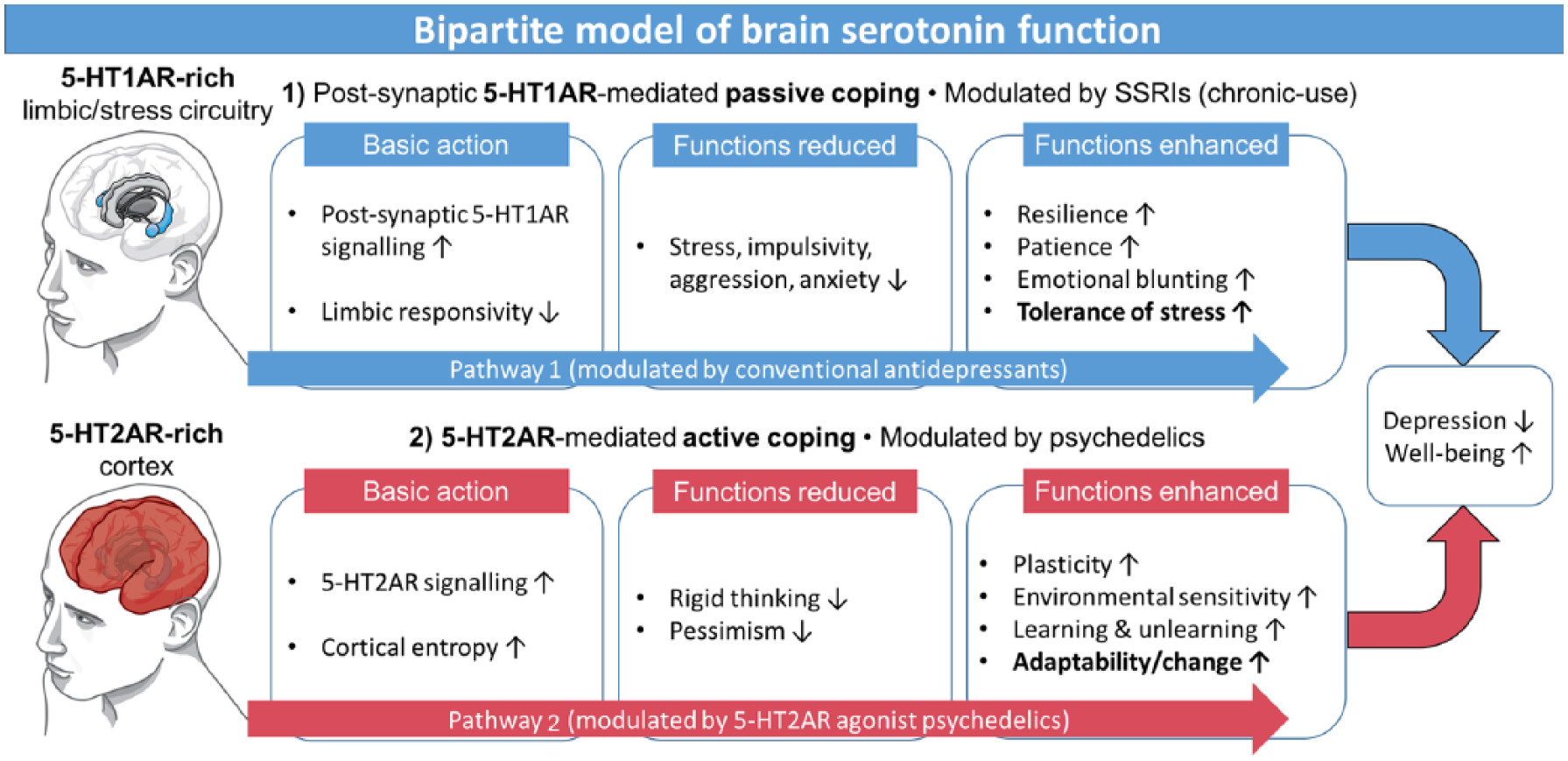
Let’s discuss serotonin neurotransmission. If you look at the two main serotonin receptors in the brain, you’ll find 5-HT1A and 5-HT2A receptors, and they enhance two distinct adaptive responses to adversity. Serotonin is crucial to our brain to enable us to moderate anxiety and stress, it does so via 5-HT1A signaling resulting in passive coping resulting in patience and resilience. 5-HT2AR signaling enables more active coping, by opening a window of plasticity and flexibility for greater adaptation.
What happens after taking psychedelics like magic mushrooms, is that they antagonize the 5-HT2AR serotonin receptors in our brains, and to a lesser extent the 5-HT1A too. Meaning you could stand to benefit from these activations across various brain regions. Neuronal 5-HT2AR agonism promotes neuroplasticity, learning, and cognitive and psychological flexibility, with therapeutic potential.
But it’s not just impacting the brain. 5-HT2AR serotonin receptors are not exclusively located in the brain; they are also found in various other tissues throughout the body. These receptors play roles in multiple physiological processes, including those related to the cardiovascular system (1), the gastrointestinal tract, and the immune system, among others. Their widespread distribution means that the effects of serotonin and serotonin-like substances can influence both central and peripheral systems.
The magic of mushrooms
Psychedelics like mushrooms have lately been implied in scientific work claiming things like effective treatment of psychological diseases like depression, PTSD, and others. As if the hype wasn’t yet big enough, psychedelics seem to be as potent as to enhance nerve growth in paralyzed organisms. Jim Harris, an athlete who became paralyzed after a snowkiting accident, found significant improvement in his condition after consuming psilocybin, a psychoactive compound found in magic mushrooms. Despite extensive physical therapy, Harris struggled to activate his right hamstring until his experience with psilocybin at a music festival, which led to a breakthrough in his recovery.
This anecdote aligns with emerging research suggesting psychedelics could promote physical healing, particularly for spinal cord injuries and traumatic brain injuries (TBI), often in conjunction with post-traumatic stress disorder (PTSD). Studies have shown psychedelics can stimulate neuroplasticity and neurogenesis, potentially explaining their healing effects. Current research includes a study from Stony Brook University where paralyzed rats treated with LSD and neurotrophin-3 showed faster recovery, highlighting the potential for psychedelics in treating spinal cord injuries. Further studies are exploring psilocybin's impact on TBI, with researchers investigating both microdoses and larger doses for their varying effects.
The anti-inflammatory properties of psychedelics, crucial for treating conditions associated with chronic inflammation like head trauma, are also under investigation. Psilocybin's ability to reduce inflammation and promote healing could represent a significant advancement in treatment methodologies.
The Last Of Us
When learning about current research on psychedelics, especially magic mushrooms, something didn’t sit well with me. What on earth would be the evolutionary basis for these organisms to have such a profound biological effect on our bodies? Spurring nerve cell growth across our bodies, even going so far as letting the paralyzed walk again? And that’s when I remembered watching a BBC documentary about the cordyceps fungus.
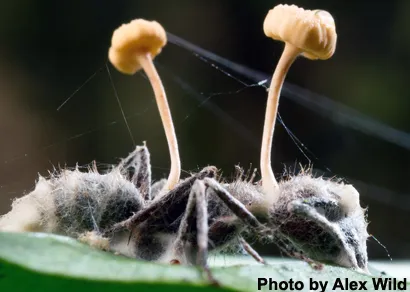
Cordyceps is a master of mind control in the insect world. Spores, tiny harbingers of doom, latch onto unsuspecting ants, burrowing into their bodies. Inside, the fungus begins its slow, methodical takeover. Like a thief in the night, it steals nutrients, weakening the ant. Soon, the ant's behavior changes. It wanders, its once-purposeful stride replaced by a disoriented shuffle. But this isn't random chaos; the fungus is pulling the strings.
Guided by an unseen puppeteer, the ant climbs. Up, up it goes, to a preordained location – often the underside of a leaf at a specific height in the vicinity of the colony guaranteeing a continual supply of new hosts. Reaching its final destination, the ant performs its last act of loyalty: it bites down, firmly gripping the leaf in a "death grip." This isn't a fight for survival; it's a sacrifice. The fungus has reached its ultimate goal. Bursting from the ant's head like a gruesome flower, the fruiting body of the cordyceps releases a cloud of spores. These new assassins disperse, seeking their next victims, perpetuating the chilling cycle. It's a story of survival, albeit a brutal one. The cordyceps doesn't care about suffering; it's simply exploiting a vulnerability to ensure its existence.
What is going on here is the fungus doing physical manipulation of the ant’s muscle fibers, growth into the brain itself, and impacting behavior also via chemicals. Scientists are in turn discovering that many fungi seem to be harboring bacteria inside themselves, some of which might be pulling strings, but I’m disgressing. Nature lives inside nature, lives inside nature, etc…
The first forms of fungi evolutionary appeared to be endosymbiotic of eukaryotic hosts (Bonneville et al. 2020) and relied on their hosts for primary metabolism (Berbee, James, and Strullu-Derrien 2017; Strullu-Derrien et al. 2018). These early fungi were zoosporic, which diverged more than 700 million years ago into non-flagellated fungi, followed by the most diverse fungal lineage of Dikarya around 642 Ma (Tedersoo et al. 2018). These diversification events were associated with fungal land colonization, which coincided with the diversification and colonization of land by plants and animals (Berbee, James, and Strullu-Derrien 2017; Minter et al. 2017; Lutzoni et al. 2018).
Based on fossil evidence, the earliest animal-associated fungi are likely parasites that shifted their interactions from plants to insects (Lepidoptera), and these fungi show a Cretaceous diversification like that of their insect and plant hosts (4). So it should come as no surprise that fungi evolved with a set of tools to manipulate host biology and the nervous system, going as far as controlling the muscle fibers in some species of insects.
When the producers of HBO's adaptation of The Last of Us saw the BBC documentary about cordyceps and zombie ants, they based their scenario on a fungus or mold pandemic creating a human zombie apocalypse. Some parts of it are realistic, but only in regards to ants, the relation between the fungus and the insect species it can “zombify” is rather specific. And humans have very different bodies from these insects.
It’s not entirely inconceivable that due to global warming, some mind-controlling fungi (of an estimated 1.5–5 million fungal species only around 120,000 have been described, (Hawksworth and Lucking, 2017)), could start to infect humans. It’s just highly unlikely. Predominantly because we are no insects. And now we’re coming to the crux of the story as to why these fungi can have such profound effects on our brains and bodies, it is that these psychedelic alkaloids like psilocybin, serve a function in fungi and even in plants where these are used as secondary compounds to steer behavior in predator species or pollinators. This could be used against predators to prevent being eaten, or it could be used to control pollinators to increase the pollination radius.
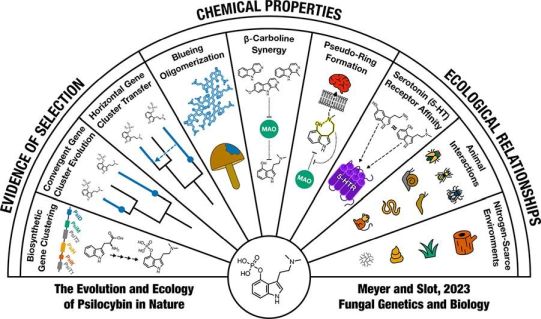
For example, in one of its developmental stages, the entomopathogenic fungal genus Massospora alters the behavior of male cicadas by using cathinone (an amphetamine) and psilocybin (a tryptamine) to cause males to simulate the behavior of sexually receptive females (Boyce et al. 2018, Cooley et al. 2018). This chemical manipulation causes males to attempt copulation with the infected pseudo-female, leading to further transmission of fungal spores. We could thus regard psychedelics as massive tools of psyops being used against certain animals to steer and influence their behavior.
But this is not only about fungi perse, many of the most well-known psychedelics are indole compounds. Indoles are characterized by a two-ring structure that includes a benzene ring fused to a pyrrole ring, and this structure forms the backbone of numerous bioactive compounds, including several psychedelics. Indole compounds are inter-kingdom signaling molecules, used by bacteria, plants, and fungi, and have the potential to act as biocontrol agents, particularly in the context of insect control. They can deter butterfly oviposition and influence the behavior of insects, making them potential candidates for insecticides, repellents, or attractants.
Indoles produced by soil microbes can modulate foraging behavior and pathogen-induced olfactory learning in nematodes, such as Caenorhabditis elegans, suggesting their role in controlling nematode populations.
Insects can detect several indole compounds, which can influence their behavior. Humans don’t have these insect receptors for various indoles, but in humans, indole compounds have been positively implicated in the prevention of human diseases such as diabetes, obesity, atherosclerosis, and cancers. If you want a deep dive into the link between indoles, tryptophan, and human health see the article BIOS NEEDS TRYPTOPHAN.
Benefits Of Psychedelics
-
Neuroplasticity Enhancement Psychedelics have been shown to promote neuroplasticity, which is the brain's ability to form new neural connections. This capacity is crucial for learning, memory, and the recovery of the brain from injuries or diseases. As the brain ages, its neuroplasticity typically declines, but psychedelics might counteract this trend, potentially aiding in the maintenance or improvement of cognitive functions.
-
Mental Health Improvement Clinical studies indicate that psychedelics can have significant therapeutic effects on mental health conditions such as depression, anxiety, and PTSD, which may become more prevalent or exacerbated with age. By potentially reducing the symptoms of these conditions, psychedelics could indirectly contribute to improved brain health and quality of life in older adults.
-
Reduced Inflammation Some research suggests that psychedelics may have anti-inflammatory effects. Since inflammation is linked to neurodegenerative diseases like Alzheimer's and Parkinson's, which affect many older adults, psychedelics might offer a protective benefit by reducing inflammation and its harmful effects on the brain.
-
Cognitive Flexibility Psychedelics may increase cognitive flexibility, allowing older individuals to adapt to new situations and solve problems more effectively. This adaptability can counteract the rigidity in thinking and behavior that sometimes accompanies aging, potentially leading to improved cognitive functioning and resilience against age-related cognitive decline.
-
Enhanced Emotional Well-being Experiences induced by psychedelics often lead to increased feelings of connectedness, empathy, and well-being. These emotional benefits can play a significant role in an individual's overall mental health, particularly in combating feelings of isolation and loneliness that may increase with age.
-
Neurogenesis There is evidence to suggest that psychedelics can stimulate neurogenesis, the process of creating new neurons in the brain. This could be particularly beneficial in aging, as it might help to counteract the natural decline in neuron production, maintaining cognitive functions and memory.
(1) Wsół, A. (2023). Cardiovascular safety of psychedelic medicine: current status and future directions. Pharmacological Reports, 75(6), 1362-1380.
(2) Luppi, A. I., Girn, M., Rosas, F. E., Timmermann, C., Roseman, L., Erritzoe, D., ... & Carhart-Harris, R. L. (2024). A role for the serotonin 2A receptor in the expansion and functioning of human transmodal cortex. Brain, 147(1), 56-80.
(3) Meyer, M., & Slot, J. (2023). The Evolution and Ecology of Psilocybin in Nature. Fungal Genetics and Biology, 103812.
(4) Bahram, M., & Netherway, T. (2022). Fungi as mediators linking organisms and ecosystems. FEMS Microbiology Reviews, 46(2), fuab058.




评论 (0)